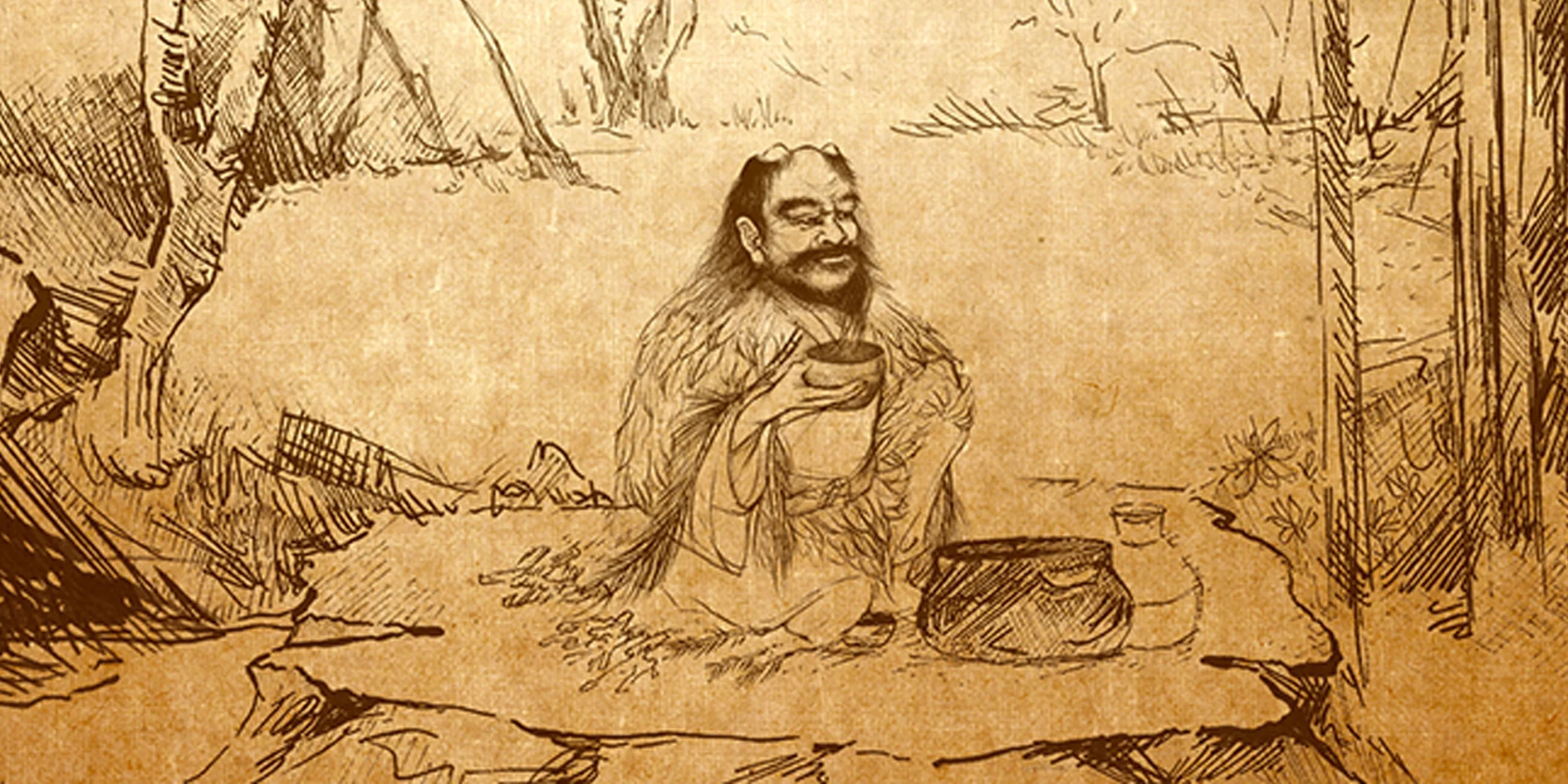Introduction
When we think about tea, images of the charming Darjeeling tea estates or the busy streets of Kolkata, where the scent of freshly brewed chai fills the air, frequently come to mind. Have you ever thought about the intriguing myth that surrounds the invention of tea, though? India, a nation with a deep cultural history, has a riveting story that has been passed down for thousands of years. Come us on a trip through time as we investigate the history of tea and the Indian folklore around its discovery.
The Legend of Bodhidharma
The mythology is said to have started with an Indian monk by the name of Bodhidharma, also known as Daruma in Japan, in the sixth century. According to legend, Bodhidharma, who is regarded as the founder of Zen Buddhism, was instrumental in bringing Buddhism to China.
According to legend, Bodhidharma set off on a protracted journey to China in order to preach his teachings. He arrived at the Shaolin Temple in China eager to teach the monks there the benefits of mindfulness and meditation. He quickly realised, though, that many of the monks had trouble staying awake during their meditation sessions, which was impeding their development.
The Revelation of Tea
Bodhidharma withdrew to a nearby cave and began to meditate for days on end in an effort to help the monks in their practise. He spent many nights without sleep until becoming exhausted one day. He picked a few leaves from a nearby plant and chewed them, determined to stay awake and continue his meditation.
To his surprise, the leaves jolted him back to life, reviving both his body and intellect. He understood that this lowly plant had a lot of promise. According to tradition, Bodhidharma thus discovered tea’s amazing virtues.
Tea’s Journey through Time
Bodhidharma brought tea to the Shaolin monks after having this epiphany because he believed it would help them stay awake and alert during their lengthy meditation periods. They began relying heavily on this newly discovered beverage because they thought it would improve their spiritual practise.
Tea became increasingly popular throughout time, ultimately making its way outside of China. Chinese culture and daily life adopted tea as a staple during the Tang Dynasty (618–907 AD).
Indian Contributions to Tea Cultivation
While the Bodhidharma mythology links India to the invention of tea, it’s crucial to remember that tea has a rich history and culture in India. For many years, India has made a substantial contribution to the growth and production of tea.
During the colonial era, the British brought commercial tea cultivation to India. The world’s largest producer of tea today, India is renowned for the wide variety of teas it produces, including the well-known Darjeeling, Assam, and Nilgiri teas.
Conclusion
The persistent connection between tea and spirituality is evidenced by the myth that Bodhidharma discovered tea. Although the legend’s historical veracity may be in question, it serves as a metaphor for the significant influence tea has had on human civilization and the quest for enlightenment.
Tea has developed into a beloved beverage across the world thanks to its wide variety of flavours, health advantages, and social importance. The history of tea continues to enthral and inspire people all across the world, from the serene tea rooms of Japan to the busy tea shops of India.
Take a moment to appreciate the old Indian folklore that goes along with this beloved beverage the next time you enjoy a cup of tea. Allow the flavours and aromas to take you back in time.
Important Information: Verizon Wireless Customer Service Phone Numbers
Source
https://www.teamuse.com/article_001001.html
https://theculturetrip.com/asia/china/articles/a-brief-history-of-tea-in-china/
https://www.teabox.com/blog/history-of-tea-in-india/
https://www.india.com/travel/articles/how-tea-came-to-india-the-untold-story-of-chai-3174055/
FAQ
Q: Is the legend of Bodhidharma and the discovery of tea historically accurate?
A well-known folktale that has been passed down through the years tells the story of Bodhidharma and the discovery of tea. Although it has cultural importance, its historical correctness is questionable. The precise circumstances of tea’s discovery are not confirmed by any hard historical evidence. It’s crucial to remember that legends frequently function more as symbolic tales than factual ones. However, the narrative emphasises the link between tea, spirituality, and the cultural significance of this popular brew.
Q: What role did India play in the cultivation of tea?
India has contributed significantly to the growing and manufacturing of tea. In the 19th century, during the British colonial era, tea planting was introduced to India. Large-scale tea plantations were built by British planters in places like Darjeeling, Assam, and Nilgiri. These areas quickly gained a reputation for producing high-quality teas with distinctive flavours and properties. India is currently one of the world’s top producers of tea, offering a wide variety of teas that are savoured both locally and abroad.
Q: What are some famous tea varieties from India?
India is known for its distinct tea varieties. Some of the famous teas from India include:
- Darjeeling tea is sometimes referred to as the “Champagne of Teas.” It is grown in the scenic hills of Darjeeling, West Bengal. It is renowned for its refined taste and flowery scent.
- Assam Tea: This strong and full-bodied tea is grown in Northeast India’s Assam area. It is well-liked for its powerful malt flavor and is frequently used in breakfast mixes.
- Nilgiri Tea: This tea, which is grown in the Nilgiri Hills in southern India, is renowned for its vibrant liquor and flavorful flavor. It works nicely with various flavors and is frequently used in iced teas.
- Kangra Tea: Kangra tea, grown in Himachal Pradesh’s Kangra area, is becoming more well-known for its delicate flavor and flowery undertones.
These are just a few examples, and India offers a wide range of other teas, including green tea, white tea, and specialty blends.
Q: How is tea consumed in India?
In Indian culture, tea has a unique position, and different regions of the nation consume different amounts of it. Chai or masala chai is the most widely consumed type of tea in most places. To make it, tea leaves are simmered with milk, water, cardamom, ginger, and a sweetener like sugar. Chai is a sociable beverage that unites people and is frequently consumed numerous times each day.
India has a practise of consuming a variety of specialised teas in addition to chai. Black teas, green teas, herbal brews, and regional specialties like Kashmiri Kahwa or South Indian filter coffee are examples of these.
Q: What are the health benefits of tea?
It is well-recognized that tea, especially green and black tea, may have health advantages. Among the advantages are:
- Tea includes catechins and flavonoids, which are antioxidants that help shield the body from harm caused by free radicals.
- Heart health: Regular tea drinking has been linked to decreased cholesterol levels and a lower risk of heart disease.
- Weight management: Some tea ingredients, such as catechins, and caffeine, may help speed up metabolism and encourage weight reduction.
- Caffeine, which is included in tea, can increase mental alertness and enhance cognitive performance.
Individual reactions to tea might differ, therefore it’s crucial to keep in mind that excessive caffeine consumption is to be avoided. It is essential to speak with a healthcare expert for personalized advice before making any dietary decisions.
Q: How can I explore and experience Indian tea culture?
To explore and experience Indian tea culture, you can:
Visit tea gardens: Make travel plans to places like Darjeeling, Assam, or Nilgiri where you may go to tea gardens, see how tea is made, and partake in tea tastings.
Attend tea festivals: Keep an eye out for gatherings that highlight the wide variety of Indian teas. Tea tastings, workshops, and cultural presentations are frequently included in these events.
Discover tea houses and tea stalls: You may discover tea houses and tea stalls in cities and towns all around India where you can try many sorts of tea, including regional delicacies.
Try tea tourism: A number of tea estates provide lodgings where guests may stay amidst the verdant greens of the tea gardens, become fully immersed in the brewing process, and discover the culture of tea for themselves.

